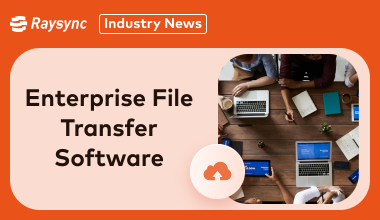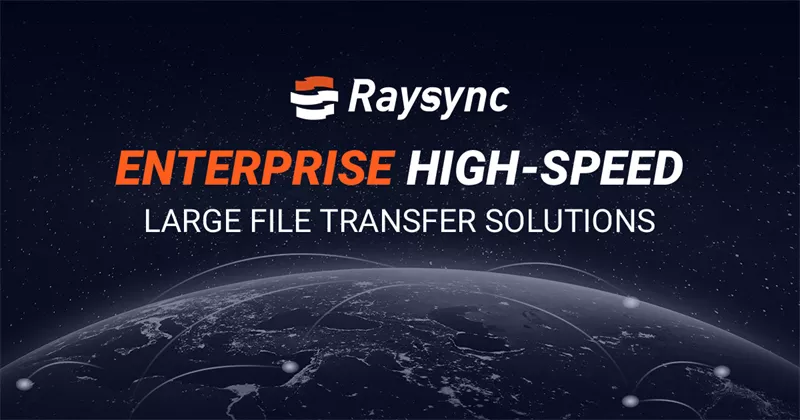4 Popular Enterprise File Transfer Software Solutions
June 14, 2024In today's digital age, enterprises require robust and efficient methods to transfer files securely and quickly. Choosing the right enterprise file transfer software can significantly impact a company's productivity and data security.
This blog explores four types of enterprise file transfer software you should know about, highlighting their unique features, applications, and benefits. In the later section, we are going to talk about the free and paid versions of different software available for enterprise file transfer.

4 Types of Enterprise File Transfer Software You Should Know
Enterprise file transfer software allows organizations to securely and efficiently exchange large files with trading partners, vendors, and internal users. There are four main types of enterprise file transfer software:
- Managed File Transfer (MFT) Solutions
- File Transfer Protocol (FTP) Solutions
- High-Speed File Transfer
- Cloud-Based File Transfer
Scroll down to learn more details of the above 4 types of enterprise file transfer software.
No 1. Managed File Transfer (MFT) [Focus on Management]
Managed File Transfer (MFT) solutions provide a secure, reliable, and centralized way to transfer data across an enterprise.
They are designed to handle a wide variety of file transfer needs, including large volumes of data and sensitive information. MFT solutions focus on ensuring compliance with regulatory requirements and providing end-to-end visibility of file transfers.
Example Apps as Enterprise File Transfer Management Software:
- IBM Sterling File Gateway
- Cleo Integration Cloud
- GoAnywhere MFT
Features:
- Security and Compliance: MFT solutions typically offer robust encryption, secure protocols, and compliance with regulations such as GDPR, HIPAA, and PCI DSS.
- Centralized Management: Provides a single platform to manage all file transfers within an organization.
- Automated Workflows: Supports automation of file transfer processes, reducing manual intervention and the risk of errors.
- Detailed Reporting: Offers comprehensive reporting and audit logs to monitor file transfers and ensure data integrity.
- Scalability: Capable of handling large-scale data transfers, making it suitable for enterprises of all sizes.
No 2. File Transfer Protocol (FTP) Solutions [Commonly Used]
File Transfer Protocol (FTP) solutions have been a staple in the file transfer industry for decades. They provide a straightforward and reliable method for transferring files between systems over a network. Despite newer technologies, FTP remains widely used due to its simplicity and ease of implementation.
Example Apps:
- FileZilla (Support SFTP)
- WinSCP
- SolarWinds FTP Voyager
Features:
- Ease of Use: FTP solutions are generally easy to set upand use, requiring minimal technical expertise.
- Basic Security: While traditional FTP lacks encryption, secure variants like FTPS and SFTP add layers of security.
- Wide Compatibility: FTP is supported by virtually all operating systems and network configurations.
- Batch Transfers: Capable of handling multiple files and large directories in a single transfer session.
- Integration: Easily integrates with existing systems and workflows, making it a versatile choice for many organizations.
No 3. High-Speed File Transfer [Focus on Speed]
High-speed file transfer solutions are designed to move large volumes of data quickly and efficiently. These solutions are essential for industries where time-sensitive data transfers are critical, such as media and entertainment, finance, and healthcare.
Example Apps:
- Aspera (by IBM)
- Raysync
- Signiant
- FileCatalyst
Features:
- High Performance: Utilizes advanced protocols and technologies to maximize transfer speeds, often exceeding traditional methods by a significant margin.
- Reliability: Ensures data integrity and delivery even in challenging network conditions.
- Scalability: Capable of transferring large files and datasets, making them suitable for enterprise-level needs.
- Bandwidth Optimization: Efficiently uses available bandwidth to reduce transfer times without affecting other network operations.
- Security: Incorporates robust encryption and security measures to protect sensitive data during transit.
No 4. Cloud-Based File Transfer [Cost-Effective Option]
Cloud-based file transfer solutions leverage cloud infrastructure to provide a flexible, scalable, and cost-effective way to transfer files. These solutions are ideal for businesses looking to reduce IT overhead and benefit from the scalability of the cloud.
Example Apps:
- Dropbox Business
- Google Drive
- Box
Features:
- Scalability: Easily scales to accommodate growing data transfer needs without significant upfront investment.
- Accessibility: Provides access to files from anywhere with an internet connection, facilitating remote work and collaboration.
- Integration: Integrates seamlessly with other cloud services and enterprise applications.
- Cost-Effectiveness: Reduces the need for expensive on-premises hardware and infrastructure.
- Security: Offers robust security features, including encryption, access controls, and compliance with industry standards.
The Fastest Enterprise File Transfer Software Recommended - Raysync
Raysync is a high-speed enterprise file transfer software designed to meet the needs of modern businesses. It offers fast, secure, and reliable file transfers, making it an excellent choice for organizations looking to enhance their data transfer capabilities.
It is also a enterprise file sharing software with multiple features in file sharing and synchronization.

Features:
- High-Speed Transfers: Leverages advanced technology to achieve transfer speeds upto 100 times faster than traditional methods.
- Robust Security: Implements AES-256 encryption, SSL/TLS protocols, and comprehensive security measures to protect data.
- User-Friendly Interface: Easy to use with a clean and intuitive interface, reducing the learning curve for new users.
- Cross-Platform Support: Compatible with various operating systems, including Windows, macOS, and Linux.
- Detailed Reporting: Provides real-time monitoring, detailed logs, and reports to ensure transparency and accountability.
Pricing:
Raysync offers flexible pricing plans tailored to different business needs.
|
|
Raysync | ||
|
|
On-Premises Enterprise | On-Premises SMB | Cloud |
|
Pricing (Start at ) |
$5,999 / Year | $1,599 / Year | $99 / Month |
|
Storage (Start at) |
On-Premises | On-Premises | 1T |
|
Speed limitation (Start at) |
1 Gbps | 1 Gbps | 1 Gbps |
|
User limitation |
Unlimited | 10 | 10 |
How People Talk About This Software (Pros and Cons)
Pros:
- Exceptional transfer speeds
- Strong security features
- Easy to use and integrate with existing systems
- Reliable performance
Cons:
- Higher cost compared to some traditional solutions
- Limited customization options in some plans
Conclusion
Choosing the right enterprise file transfer software is crucial for ensuring efficient, secure, and reliable data transfer within your organization. Whether you need the comprehensive management features of MFT, the simplicity of FTP, the speed of high-speed transfer solutions, or the flexibility of cloud-based options, there is a solution to meet your needs.
You might also like
![List of Rsync Alternatives in 2025 [Free-Open Source]](http://images.ctfassets.net/iz0mtfla8bmk/17jmYut16Z2exAbYzgb1TB/ba071f602b658a049ad6667a0a1df92e/rsync-alternative.png)
Industry news
February 7, 2025Looking for Rsync Alternatives in 2025? This curated list showcases free and open-source tools, providing robust and efficient file synchronization and transfer solutions
![Top 7 Large File Transfer Services [Latest Update]](http://images.ctfassets.net/iz0mtfla8bmk/IDPUTyroYc6ZqDD4a8vIN/f8011e72259ca948035e0867a94beb75/large-file-transfer-service.png)
Industry news
August 16, 2024Discover the best large file sharing services for both personal and business use, and find out which service offers the most value for transferring big files.
![Top 7 P2P File Sharing Websites [Individual/Enterprise]](http://images.ctfassets.net/iz0mtfla8bmk/4Ycs5DIopDv0CIfOOIIHsN/d84a05c4e3fe38cec9ccae1e67afc36e/p2p-file-sharing-website.png)
Industry news
June 26, 2024Explore the top 7 p2p file-sharing websites tailored for both individuals and enterprises for secure and efficient file sharing.